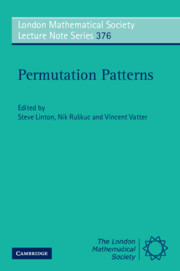Book contents
- Frontmatter
- Contents
- Preface
- Some general results in combinatorial enumeration
- A survey of simple permutations
- Permuting machines and permutation patterns
- On three different notions of monotone subsequences
- A survey on partially ordered patterns
- Generalized permutation patterns – a short survey
- An introduction to structural methods in permutation patterns
- Combinatorial properties of permutation tableaux
- Enumeration schemes for words avoiding permutations
- The lexicographic first occurrence of a I-II-III-pattern
- Enumeration of partitions by rises, levels and descents
- Restricted patience sorting and barred pattern avoidance
- Permutations with k-regular descent patterns
- Packing rates of measures and a conjecture for the packing density of 2413
- On the permutational power of token passing networks
- Problems and conjectures
- References
An introduction to structural methods in permutation patterns
Published online by Cambridge University Press: 05 October 2010
- Frontmatter
- Contents
- Preface
- Some general results in combinatorial enumeration
- A survey of simple permutations
- Permuting machines and permutation patterns
- On three different notions of monotone subsequences
- A survey on partially ordered patterns
- Generalized permutation patterns – a short survey
- An introduction to structural methods in permutation patterns
- Combinatorial properties of permutation tableaux
- Enumeration schemes for words avoiding permutations
- The lexicographic first occurrence of a I-II-III-pattern
- Enumeration of partitions by rises, levels and descents
- Restricted patience sorting and barred pattern avoidance
- Permutations with k-regular descent patterns
- Packing rates of measures and a conjecture for the packing density of 2413
- On the permutational power of token passing networks
- Problems and conjectures
- References
Summary
Abstract
Structural methods as applied to the study of classical permutation pattern avoidance are introduced and described. These methods allow for more detailed study of pattern classes, answering questions beyond basic enumeration. Additionally, they frequently can be applied wholesale, producing results valid for a wide collection of pattern classes, rather than simply ad hoc application to individual classes.
Introduction
In the study of permutation patterns, the important aspects of permutations of [n] = {1, 2, …, n} are considered to be the relative order of both the argument and the value. Specifically, we study a partial order, denoted ≼ and called involvement, on the set of such permutations where π ∈ Sk is involved in σ ∈ Sn, i.e. π ≼ σ if, for some increasing function f : [k] → [n] and all 1 ≤ i < j ≤ k, σ(i) < σ(j) if and only if π(f(i)) < π(f(j)). This dry and uninformative definition is necessary to get us started, but the reader should certainly be aware that another definition of involvement is that some of the points in the graph of π can be erased so that what remains is the graph of σ (possibly with a non-uniform scale on both axes) – in other words the pattern of σ (its graph) occurs as part of the pattern of π.
Information
- Type
- Chapter
- Information
- Permutation Patterns , pp. 153 - 170Publisher: Cambridge University PressPrint publication year: 2010
